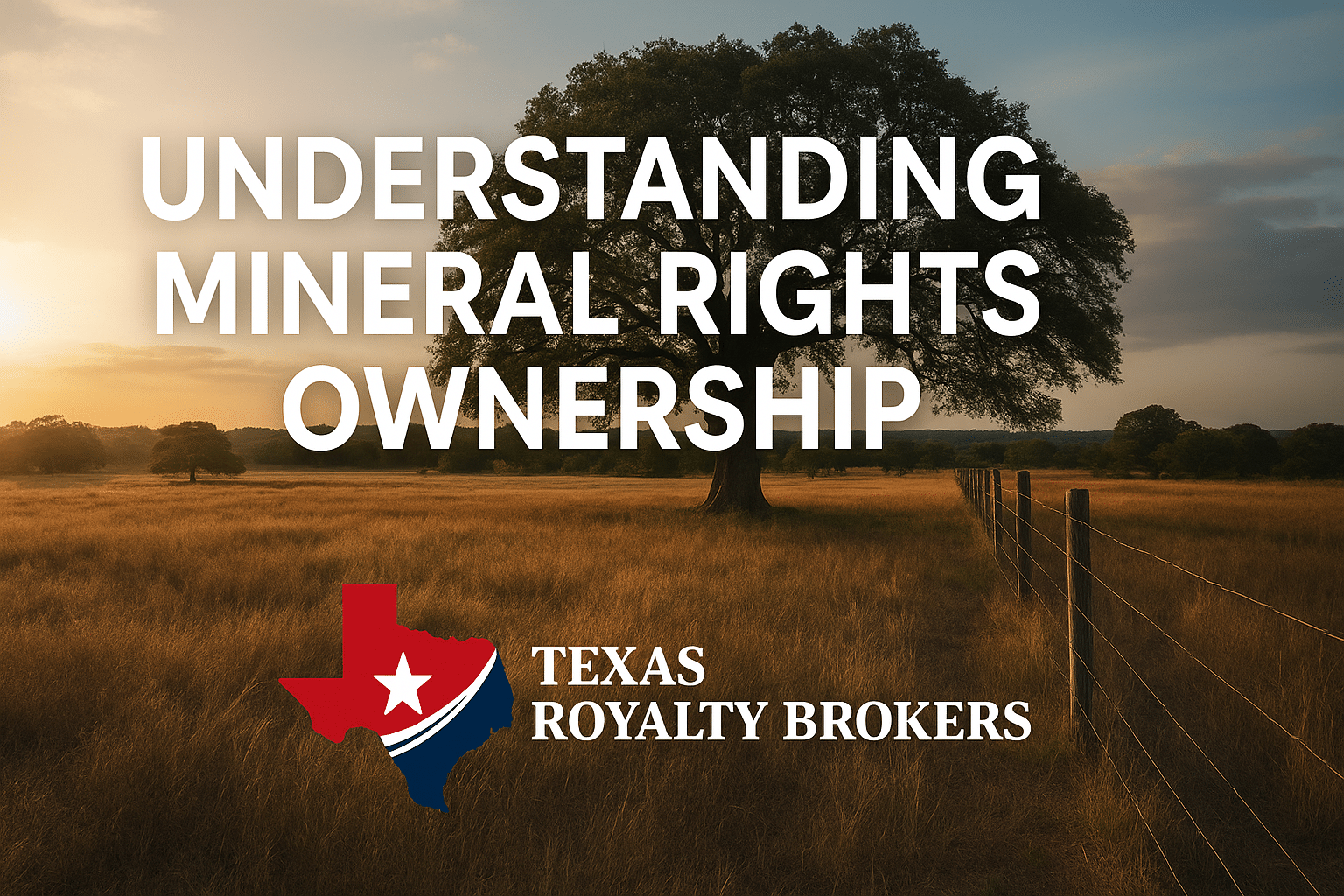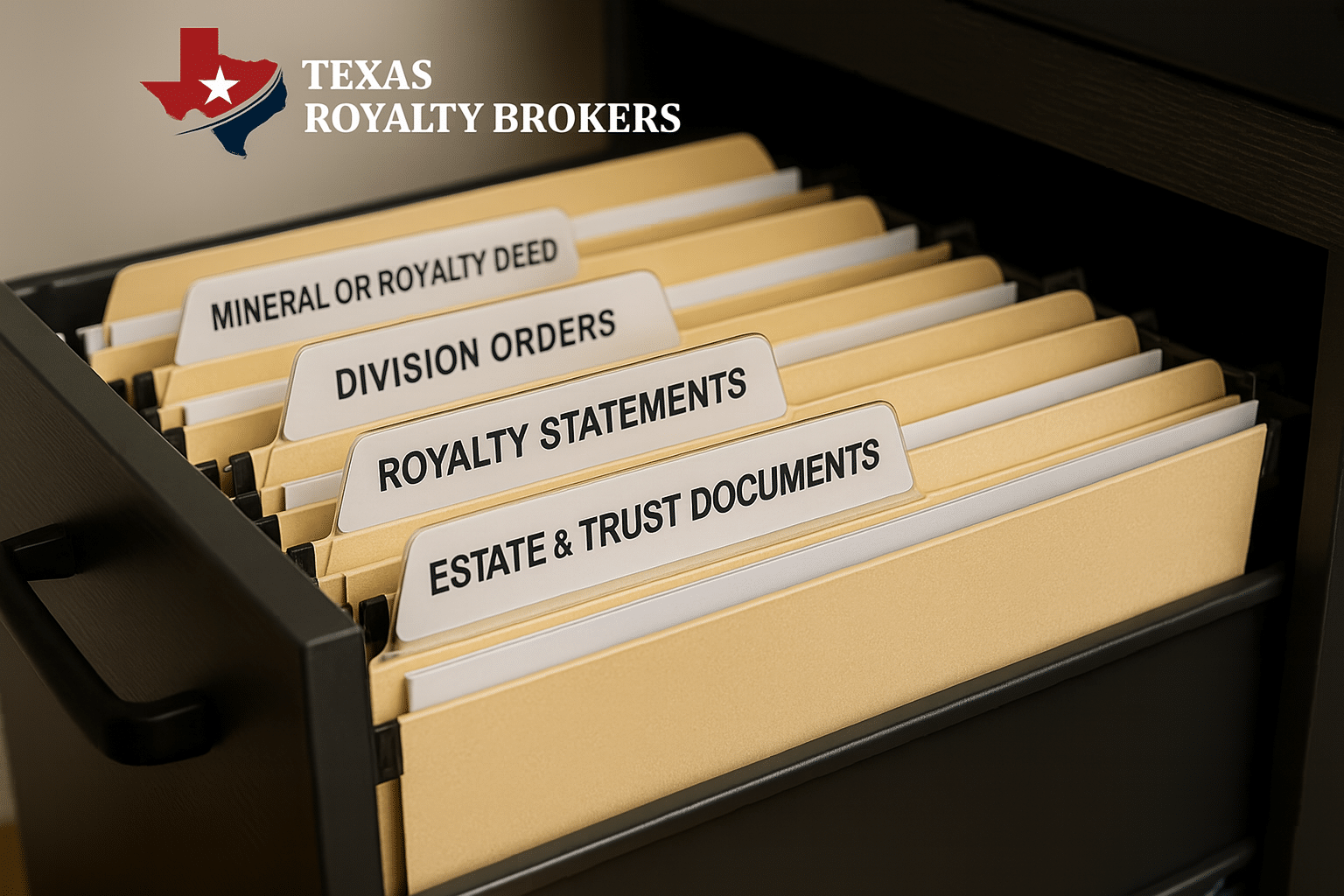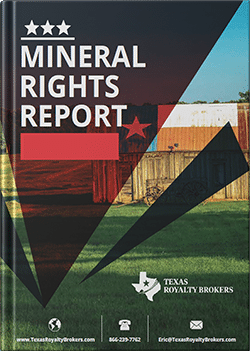Why Texas Royalty Brokers?
sellers
Buyers
State Specific Guides
Resources
Understanding Mineral Rights Ownership in Texas
If you recently found out you own mineral rights, or you’ve been receiving royalty checks and aren’t quite sure why, you’re not alone.
Mineral rights ownership can feel overwhelming at first. Between legal documents, royalty payments, and industry terms, it’s easy to get lost in the details.
Whether you inherited mineral rights, bought land that came with them, or are simply trying to understand your options, this guide is for you.
We’re going to break down what mineral rights ownership means, how it works in Texas, and what you need to know to make smart decisions. Our goal is to simplify a complex topic and help you feel confident about what you own and how to protect its value.
Here’s what we’ll cover:
What Are Mineral Rights and How Do They Work in Texas?
Common Scenarios That Affect Ownership
Key Documents Every Mineral Owner Should Understand
How Surface Rights and Mineral Rights Interact
Why Working With a Mineral Rights Broker Matters
Final Thoughts – Free Consultation
Still have questions after you complete the guide? Contact us for a free consultation.
What Are Mineral Rights and How Do They Work in Texas?
In Texas, mineral rights give you ownership of the resources beneath the surface of the land. This includes oil, natural gas, and other minerals. These rights can be leased, sold, inherited, or gifted just like any other form of property.
Mineral rights are often separated from surface rights, which means one person can own the land, while someone else owns the minerals underneath. This is common in Texas and can lead to some confusion when oil or gas activity happens on land you thought was yours.
There are two main types of mineral ownership:
-
Unified or fee simple ownership, where you own both the surface and mineral rights.
-
Severed mineral rights, where the surface and subsurface rights are owned by different parties.
Tip: In Texas, it is extremely uncommon to own both the land and the mineral rights.
Mineral rights can be incredibly valuable, especially if your land is in a producing area. But without a solid understanding of how they work, it’s easy to make mistakes when leasing or selling. That’s why it’s so important to understand exactly what you own and how to manage it.
These royalties can provide an ongoing income stream for the mineral owner. However, the income may be inconsistent as production and the price of oil and gas are constantly changing.
The value of royalty interests can vary based on how much is produced, current oil and gas prices, and the terms in the lease.
Understanding how royalties work helps mineral owners make smarter decisions about their property and its value.
Common Scenarios That Affect Ownership
Mineral rights don’t always stay with the same person or family. Over time, ownership can shift for all kinds of reasons.
Here are some of the most common scenarios that affect mineral rights in Texas:
Inheritance:
Most mineral rights are passed down through families. Over generations, these rights often get split among heirs, which can result in dozens of people owning small fractions of the same property. This can complicate leasing and selling if ownership isn’t well documented. In addition, mineral rights can become so fractionalized over time that they lose value due to becoming too small to hold any value.
Divorce Settlements:
In Texas, mineral rights acquired during a marriage are typically considered community property. That means they may be divided during a divorce, just like other assets. If you’ve gone through a divorce, it’s important to make sure the mineral rights were properly accounted for.
Gifting:
While gifting mineral rights can be a thoughtful move, it can also create tax complications if it’s not handled correctly. If you’re thinking about gifting rights to children or charities, you’ll want to talk to a tax professional and make sure the paperwork is in order.
Unpaid Taxes or Foreclosure:
It’s rare, but mineral rights can sometimes be lost due to unpaid taxes or property issues. This usually happens when owners aren’t aware they even have mineral rights, or aren’t receiving royalty payments and miss important notices.
Force Pooling and Unitization:
Oil and gas development often involves pooling together mineral interests from multiple owners. This affects how royalties are calculated and how you’re paid. If your minerals are part of a pooled unit, it’s good to know what that means for your share.
Each of these scenarios can impact your ownership, royalty payments, or ability to sell. That’s why working with a mineral rights broker can be so helpful. We can untangle complex situations and make sure you don’t miss out on value you’re entitled to.
Key Documents Every Mineral Owner Should Understand
Even if you don’t plan to sell right away, keeping your documents in order is a smart move.
These are the key documents every mineral owner in Texas (or any state) should be familiar with:
Mineral or Royalty Deeds:
These documents show what you actually own. Some deeds transfer full mineral rights, while others transfer only royalty rights. Reading the fine print is essential, especially if the deed includes terms like “non-participating royalty interest” or “executive rights.”
Tip: Many mineral owners do not have a mineral rights deed. They inherited the mineral rights and there was no deed. This is normal. When you sell mineral rights, a new deed will be created.
Division Orders:
After a well starts producing, the operator will send a division order. This confirms your ownership percentage in the well and must be signed before you receive any royalty payments. It’s worth reviewing carefully to make sure your interest is listed correctly.
Royalty Check Stubs and Statements:
These monthly documents show how much oil or gas was produced, what price was paid, and what deductions were taken. Learning to read these helps you verify payments and catch errors.
Estate and Trust Documents:
If your rights were inherited or placed in a trust, make sure the ownership trail is clear. Without proper documentation, it can be hard to sell or transfer your interest later on.
Surface Use Agreements and Leases:
If your mineral rights have been leased, you’ll want a copy of the lease agreement. Surface use agreements spell out how and where oil companies can access the land, and whether they owe compensation for surface damage.
Having these documents ready will make leasing, selling, or even evaluating your minerals much easier.
If you’re not sure where to start, contact Texas Royalty Brokers. We can help get you pointed in the right direction. You may need to contact the operator, hire a lawyer, or find a landman depending on your situation.
How Surface Rights and Mineral Rights Interact
One of the most misunderstood parts of mineral ownership is how it relates to the surface of the land.
In Texas, when mineral and surface rights are owned separately, the mineral estate takes priority. That means the mineral owner (or the company leasing from them) can access the surface to extract resources.
This is where surface use agreements come into play. These agreements help protect the surface owner by setting limits on where roads, pipelines, and drilling sites can go, and ensuring compensation for damages.
There’s also a unique situation in Texas called mineral-classified land, which applies to certain properties sold by the state. In these cases, the surface owner shares mineral rights with the state of Texas, creating a special type of joint ownership that requires additional oversight and regulation.
If you own land and aren’t sure whether you also own the minerals, or how development might affect your surface, it’s worth looking into. Understanding how these two types of ownership interact can help you avoid conflicts and protect the value of both.
Why Working With a Mineral Rights Broker Matters
Selling mineral rights isn’t like selling a house or a car. The market is less transparent, and many buyers are hoping you’ll accept the first offer without knowing what your rights are really worth.
That’s where Texas Royalty Brokers comes in.
We specialize in helping mineral owners in Texas get the best possible value for their rights. We don’t just connect you with one buyer. We put your property in front of a wide network of serious, vetted mineral buyers who compete to make you the strongest offer.
Here’s what you can expect when you work with us:
-
We will review your documentation and help you understand exactly what’s going on. This is free and there is no obligation whether you list with us or not.
-
We create a professional listing that attracts high-quality buyers.
-
We manage a competitive bidding process to drive up your offers.
-
We guide you through the sale process from start to finish.
Selling on your own can lead to lowball offers, legal headaches, or deals that fall through. With Texas Royalty Brokers, you get more value with less hassle. You get experience, market knowledge, and someone in your corner the entire way.
Final Thoughts – Free Consultation
Mineral rights ownership in Texas comes with real opportunity, but also some complexity.
Whether you inherited your rights, purchased land, or are managing a family estate, understanding what you own is the first step to making informed decisions.
If you’re thinking about selling or just want to know what your mineral rights are worth, reach out to Texas Royalty Brokers. We’re here to answer your questions, give you honest guidance, and help you get the most value from your minerals.
Let us simplify the process for you. You’ll walk away with more money, less stress, and peace of mind knowing you did it the right way.
Contact us using the form below and let us guide you and help answer all of your mineral rights ownership questions.






